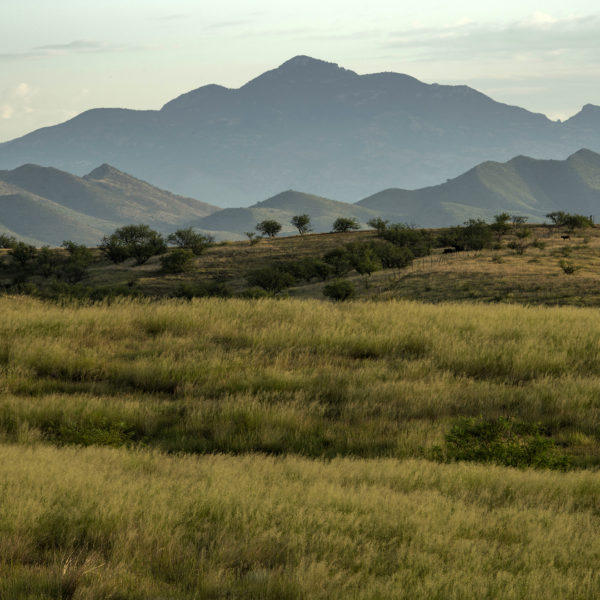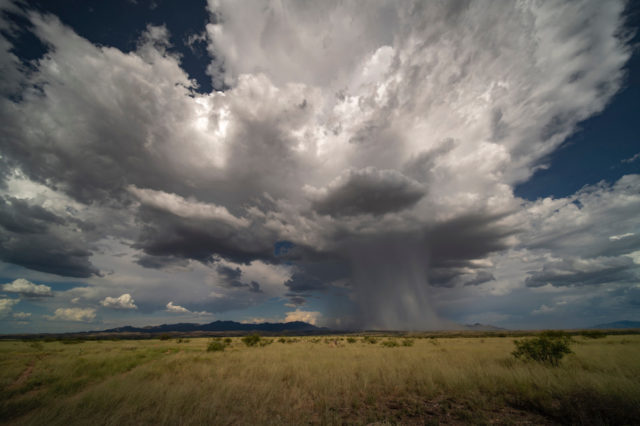“To see so many people from different walks of life coming together around a common goal was inspiring. I continue to be inspired by it.”
—Em Martin Brott, former Sonoran Institute staff
It all started with a community potluck at the Sonoita Fairgrounds in Santa Cruz County, Arizona, hosting ranchers, wildlife conservationists, hikers, mountain bikers, equestrians, and local citizens. This eclectic group came together at the invitation of the Bureau of Land Management (BLM) to share their interest in the 42,000 acres of land BLM acquired in their community and to hear about the BLM’s needs to develop a management plan for the area. Along with the dish each brought to share, most of the 100 or so people accepting the BLM’s invitation also carried with them a strong opinion about how the land should be managed and perhaps an even stronger skepticism that their voice would be heard.
In a different time, with a different cast of characters, the fairgrounds could easily have turned into a battleground. Instead, this 1995 meeting proved to be the beginning of one of the most successful and enduring collaborative conservation efforts in the nation.
Conservation takes hard work, and results are often frustratingly nebulous. Planning is measured in years, implementation in decades. Progress is incremental, and it can be hard to clearly see the benefits of the dollars and dedication that go into preserving a landscape. In 2000, the pristine Las Cienegas area received National Conservation Area designation. The recent 20th anniversary of this accomplishment offers an opportunity to recognize a very tangible conservation success and to celebrate the ideals of collaboration and bipartisanship that seem all but lost in today’s political climate.
Sonoran Institute was a young organization when the Las Cienegas story began. Looking back at our various contributions to the lasting conservation achievements in the Cienega watershed reminds us why a pollinator is our organization’s symbol.
The Place
A slice of “Big Sky” country in Arizona, the wide-open, rolling grasslands, mountain vistas, and flowing waters of Cienega Creek are only 45 miles southeast of Tucson but feel like a world away. Cattle still roam here, along with a diverse array of predominantly native plants, fish, and wildlife, including nine threatened and endangered species. The very rare perennially flowing stream supports an intact ecosystem that, by the end of the 20th century, had managed to remain largely undisturbed in a fast-growing region.
The area’s tranquility started to shift in the late 1960s, when Gulf America Corporation purchased the 50,000-acre Empire and Cienega ranches. The company planned to create a satellite community of Tucson, with a residential development of some 30,000 homes. When these plans failed, Anamax Mining Company bought the land in 1974 for the water rights to support a proposed copper mine in the Santa Rita Mountains. Since the watershed supplied a significant portion of Tucson’s water, concern grew about the future of the water resources as well as the changing character of the area. Responding to public interest, the BLM, led by then-Arizona state director Dean Bibles, acquired 35,000 acres of the property through a series of land swaps in 1988.
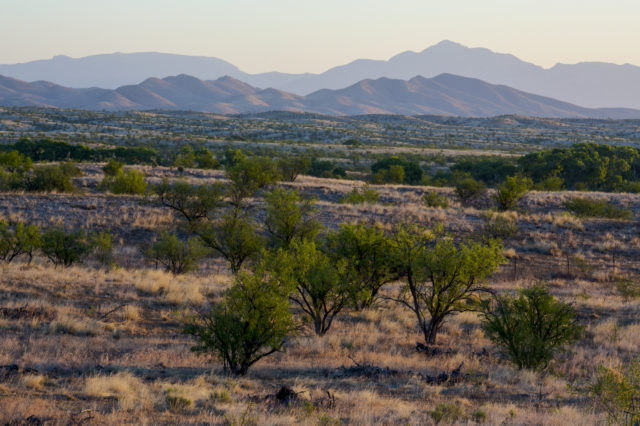
The People
As part of its mandate, the BLM began creating a resource management plan for its newly acquired land. In its traditional way, the agency created proposals internally and then sent them out to the public for comment. “We got a lot of pushback from that,” recalls Karen Simms. “People wanted to be much more engaged.” Simms is now Natural Resources Division Manager for Pima County, after stewarding the Las Cienegas area for almost 30 years. At the time of the acquisition, she was still a student, hired by the BLM to live at the Empire Ranch and conduct a resource inventory of the land. She graduated to become a field biologist and was soon in charge of creating the management plan.
Arriving in 1991 to become the first manager of the BLM’s Tucson field office, Jesse Juen felt more than pushback as he met with community leaders. “Their attitude was, ‘Dang those Feds, gobbling up land! We know you’re going to kick all the cows off here. Let’s cut to the chase–we’re going to sue you.’”
The late John Donaldson and his son, Mac, were among those with reason to feel apprehensive. They had been running a 1,500-head cow-calf operation on the Empire Ranch since the mid-1970s, when the Anamax Mining Corporation leased the ranch’s grazing rights to John. While they firmly believed that grazing was a legitimate use of the land, the Donaldsons were conservation-oriented ranchers. John’s mother, an active member of the Audubon Society, had been a strong influence, and John was dedicated to running his grazing operation in a way that minimized environmental impact.
“What intrigued him most was the repair of the land.”
—Mac Donaldson
“What intrigued him most was the repair of the land,” Mac Donaldson says. “Through careful management of water and cattle movements and other factors, he believed you could actually improve the land. That was a tenet of his for his entire life. That was where our commitment came from.” To that end, John and Mac established a “biological planning process,” an innovative approach to grazing management that involved continually analyzing and adapting their practices to improve the land and respond to changing conditions and natural resource needs. “It is a very resource-oriented management approach,” Mac Donaldson says, “a philosophy of trying to reduce conflict.”
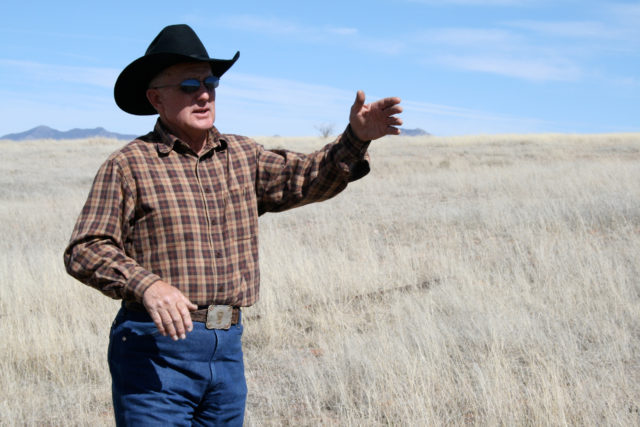
Building Bridges
Reducing conflict was on Jesse Juen’s mind as well. Judging the mood of the community, it was clear that business as usual was not going to work. Stakeholders had opinions and wanted to be involved. Juen turned to Carlos Nagel, a professional facilitator, for help. “Carlos had an amazing talent for collaboration and bringing diverse, disparate viewpoints together and really helping people learn to collaborate.”
With Nagel’s guidance, Juen and Simms set up the potluck gathering at the fairgrounds. They put invitations in every mailbox in nearby Sonoita and included anyone in the area who may have a stake, whether it was the old ranching families, recreation interests, wildlife-oriented conservation groups, or simply people with an interest in protecting the area long term. “The meeting was very well received,” Juen says. “People expressed concern, fear, angst, happiness, and joy. But we could all agree on a general goal to protect the resources for future generations. It set up a process for us to work collaboratively with the community.”
“But we could all agree on a general goal to protect the resources for future generations. It set up a process for us to work collaboratively with the community.” —Jesse Juen, Bureau of Land Management
That meeting was followed by hundreds more. Over the next five years, the group, representing a broad coalition of diverse interests, eventually organized into the Sonoita Valley Planning Partnership (SVPP) and worked together to establish goals for the future of the area and help the BLM develop its land use plan.
Signifying the high level of trust and mutual respect built through the group’s work, the Donaldsons’ biological planning process was integrated into the BLM’s plan, institutionalizing cooperative planning into the way the BLM would manage its resources. So, instead of the BLM prescribing grazing practices to ranchers, a biological planning team consisting of stakeholders and resource experts, visit the ranch twice a year to collaboratively discuss results, analyze long-term monitoring data and trends, resolve any issues, and apply the best available science going forward.
When the resource management plan was completed and presented, it faced no appeals and only one quickly resolved objection. “Everyone who might have originally had an objection was involved in developing the plan,” Mac Donaldson says. “It was very successful,” says Karen Simms. “The environmental impact statement we wrote received the highest rating from the EPA that you can get, from the quality, the collaboration, and the analysis that was done.”
A Groundswell of Support for Permanent Protection
“Community-based conservation doesn’t just happen spontaneously. The ingredients for success were there,” says Luther Propst, founder and former executive director of the Sonoran Institute. Propst had established the Sonoran Institute in 1990 and, while it was not yet directly involved with the BLM’s process, the Institute was active in the area early on.
“Jesse Juen is one of my heroes,” Propst says. “The other is Karen Simms. There was a fortuitous confluence that you had Jesse at the BLM management level and Karen in the field at that time. They saw that a traditional, agency-driven planning approach was not going to produce the outcome that everybody wanted. And they were both just great folks. That was essential to it, and that approach attracted really talented people, like the Donaldsons.”
While the SVPP planning was underway, Sonoran Institute was running a series of “Successful Communities” workshops with people from rural communities around the West to help them identify the vision for their community and scope out how to realize this vision. The “Sonoita Crossroads Forum” was designed to help the community of Sonoita grapple with the rapid growth and change it was experiencing. “There was a sense of urgency about protecting what makes the region special,” Propst says. As a result, there was strong community support for protecting their unique and fragile landscape.
The growing threats to Arizona’s rural character and the passion fueling the collaboration at Las Cienegas caught the attention of leaders at the state and national levels. With the SVPP’s planning nearing completion, former Arizona Governor and then U.S. Secretary of the Interior Bruce Babbitt floated the idea of making the Las Cienegas area a national monument by executive order. The BLM hosted a barbeque with Secretary Babbitt at the Empire Ranch, inviting the partners who had been working with them for so long. Babbitt listened to them and talked about their planning effort and why it was important. Everyone agreed that the area should be protected long term, but the group wanted it done through legislation, not executive action.
“My gut feeling was people thought, ‘We’ve invested five years out here, and we want our work codified in law!’” says Juen.
Propst believes this reaction was exactly what Babbitt wanted to hear. “He was using the power of his office in a very savvy manner. By raising the prospect of unilateral action, Secretary Babbitt spurred a vague, latent interest in protection into a strong action plan.”

In Flies the Hummingbird
At this point, the Sonoran Institute dove into action. Because it was already working in the area, the Institute had relationships with community and county leaders, public officials, developers, and the ranching families. “Sonoran Institute was there,” Juen says, “talking with people, explaining why a national designation was valuable, telling them that we would need their leadership and for them to speak up.” Luther Propst facilitated connections between local leaders and Secretary Babbitt, Congressman Jim Kolbe, and Senator John McCain. He helped gain bipartisan support from the Arizona delegation. When he finished going door-to-door in the Sonoita Valley, he did the same on Capitol Hill, working alongside John Donaldson, who also made the trip to D.C. to help Congressman Kolbe gain support for the legislation’s passage.
In December 2000, President Clinton signed into law the Las Cienegas National Conservation Area (NCA) Establishment Act (HR 2941). The Act created a 47,000-acre NCA, intermixed with 5,000 acres of state trust lands. Sonoran Institute played a key role with two important elements of the legislation. First, the Act directs the BLM to manage the NCA using the adaptive management plan developed with the SVPP, ensuring that the land continues to be managed collaboratively and with public involvement. Secondly, recognizing that the NCA is part of a much larger watershed and wildlife corridor, the Act created a wider boundary around the NCA, called the Sonoita Valley Acquisition District (SVAPD). The 96,000 acres of state, federal, county, and private lands comprising the SVAPD were identified as high priority for protection and eligible for automatic inclusion in the NCA in the event BLM acquires them.
Approximately 50,000 acres north of Las Cienegas link the NCA to national park and forest lands in the Rincon Mountains east of Tucson. Due to the complicated patchwork of state, county, and private ownership, however, this ecologically important area was not included in the SVAPD. At Sonoran Institute’s suggestion, the legislation required a study to find the best way to protect and connect this “Missing Link.”
“We highlighted the importance of the connections between Cienega Creek and the Saguaro National Park and Coronado National Forest Rincon Wilderness,” Propst explains, “and we wanted to facilitate future acquisitions and exchanges.”
The BLM invited Sonoran Institute to lead the study, which involved conducting two years of workshops, public open houses, and meetings with resource experts to collect information and develop recommendations. Delivered to Congress in 2003, the “Missing Link Report” concluded that the most effective way to protect this land was to create a community-based conservation group, whose sole focus was to work with the wide variety of public and private landowners and other parties with an interest in the area. It was the job of Sonoran Institute’s Em Martin Brott to create and lead this group, called the Cienega Corridor Conservation Council (CCCC).
In addition to running the CCCC, Brott was soon assisting Karen Simms with the SVPP meetings. “To see so many people from different walks of life coming together around a common goal was inspiring,” she says. “I continue to be inspired by it.”
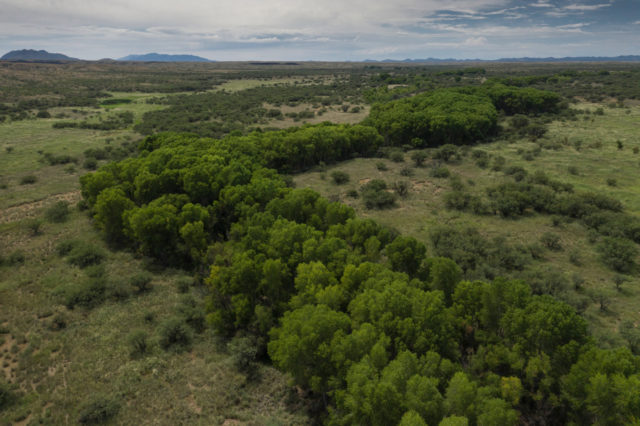
As the groups worked to implement the recommendations of the Missing Link report, one of its major initiatives was to prepare proposals on worthy open space acquisitions for Pima County. “Somebody had to be the point person doing that behind-the-scenes work and bringing together all the ideas of the diverse parties, and that was the Sonoran Institute,” Brott says. Karen Simms couldn’t have guessed it at the time, but these properties are among the 155 Pima County open space properties–including four mountain parks and twelve ranches–she is responsible for in her current position. “It’s amazing for me to now be working at Pima County and managing the county’s lands in the Missing Link area, continuing to advance the goals for protecting this important area,” she says.
The work of the SVPP became a model for collaborative engagement and received several awards, including the 2004 Clarence Burch Award from the Quivira Coalition and the 2004 Award of Excellence for Building Community Connections for its presentation at the Joint Ventures Partnership Conference. The group was also invited to participate in the White House Conference on Cooperative Conservation in 2005. Most recently, the partnership was honored to be recipients of the U.S. Department of Interior’s prestigious Partners in Conservation Award in 2013.
Enduring Collaboration
Over the years, the SVPP and CCCC merged into one, to form the Cienega Watershed Partnership (CWP). The CWP provides a collaborative framework for groups and activities stewarding both the natural and cultural resources of the Cienega Watershed. “As a partnership, we pull together all the various interests working in different parts of the watershed to look at the overall strategies and policies within the watershed,” says Tom Meixner, chairman of CWP’s all-volunteer board.
CWP and partners conduct resource monitoring and restoration. One of their major efforts has been aiding the recovery of the Chiricahua Leopard Frog. It also conducts a youth environmental stewardship project, offers watershed tours twice a year, and holds two annual education forums: the “State of the Watershed” workshop and “Science on the Sonoita Plain Symposium.”
In June 2019, about 50 people again gathered at the Sonoita Fairgrounds to discuss the future of the magnificent landscape they care so passionately about. Many still have potentially competing interests, whether it be ranching or wildlife conservation or recreation. But since the first potluck meeting here almost a quarter century ago, much has changed. Thanks to the dedication, open-mindedness, and visionary leadership of so many others, the attendees of the CWP’s 11th annual Science on the Sonoita Plain Symposium arrive on common ground, with common goals–to work in partnership for the good of the watershed.
Header and footer photos: Las Cienegas National Conservation Area. ©Bill Hatcher, 2020

